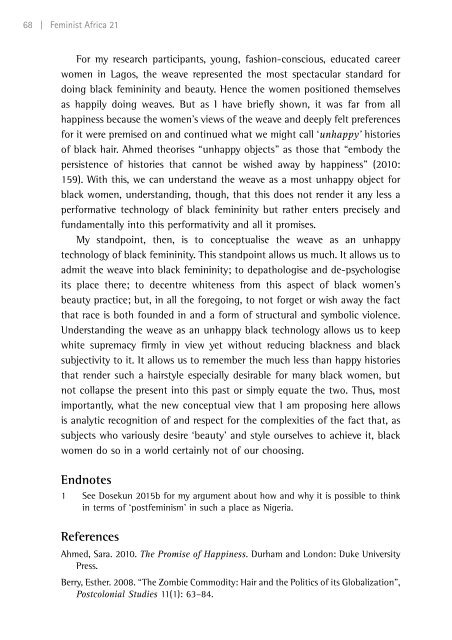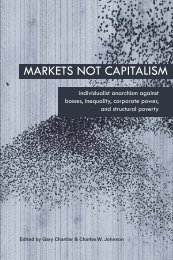The politics of fashion and beauty in Africa
fa21_proof_3
fa21_proof_3
Create successful ePaper yourself
Turn your PDF publications into a flip-book with our unique Google optimized e-Paper software.
68 | Fem<strong>in</strong>ist <strong>Africa</strong> 21<br />
For my research participants, young, <strong>fashion</strong>-conscious, educated career<br />
women <strong>in</strong> Lagos, the weave represented the most spectacular st<strong>and</strong>ard for<br />
do<strong>in</strong>g black fem<strong>in</strong><strong>in</strong>ity <strong>and</strong> <strong>beauty</strong>. Hence the women positioned themselves<br />
as happily do<strong>in</strong>g weaves. But as I have briefly shown, it was far from all<br />
happ<strong>in</strong>ess because the women’s views <strong>of</strong> the weave <strong>and</strong> deeply felt preferences<br />
for it were premised on <strong>and</strong> cont<strong>in</strong>ued what we might call ‘unhappy’ histories<br />
<strong>of</strong> black hair. Ahmed theorises “unhappy objects” as those that “embody the<br />
persistence <strong>of</strong> histories that cannot be wished away by happ<strong>in</strong>ess” (2010:<br />
159). With this, we can underst<strong>and</strong> the weave as a most unhappy object for<br />
black women, underst<strong>and</strong><strong>in</strong>g, though, that this does not render it any less a<br />
performative technology <strong>of</strong> black fem<strong>in</strong><strong>in</strong>ity but rather enters precisely <strong>and</strong><br />
fundamentally <strong>in</strong>to this performativity <strong>and</strong> all it promises.<br />
My st<strong>and</strong>po<strong>in</strong>t, then, is to conceptualise the weave as an unhappy<br />
technology <strong>of</strong> black fem<strong>in</strong><strong>in</strong>ity. This st<strong>and</strong>po<strong>in</strong>t allows us much. It allows us to<br />
admit the weave <strong>in</strong>to black fem<strong>in</strong><strong>in</strong>ity; to depathologise <strong>and</strong> de-psychologise<br />
its place there; to decentre whiteness from this aspect <strong>of</strong> black women’s<br />
<strong>beauty</strong> practice; but, <strong>in</strong> all the forego<strong>in</strong>g, to not forget or wish away the fact<br />
that race is both founded <strong>in</strong> <strong>and</strong> a form <strong>of</strong> structural <strong>and</strong> symbolic violence.<br />
Underst<strong>and</strong><strong>in</strong>g the weave as an unhappy black technology allows us to keep<br />
white supremacy firmly <strong>in</strong> view yet without reduc<strong>in</strong>g blackness <strong>and</strong> black<br />
subjectivity to it. It allows us to remember the much less than happy histories<br />
that render such a hairstyle especially desirable for many black women, but<br />
not collapse the present <strong>in</strong>to this past or simply equate the two. Thus, most<br />
importantly, what the new conceptual view that I am propos<strong>in</strong>g here allows<br />
is analytic recognition <strong>of</strong> <strong>and</strong> respect for the complexities <strong>of</strong> the fact that, as<br />
subjects who variously desire ‘<strong>beauty</strong>’ <strong>and</strong> style ourselves to achieve it, black<br />
women do so <strong>in</strong> a world certa<strong>in</strong>ly not <strong>of</strong> our choos<strong>in</strong>g.<br />
Endnotes<br />
1 See Dosekun 2015b for my argument about how <strong>and</strong> why it is possible to th<strong>in</strong>k<br />
<strong>in</strong> terms <strong>of</strong> ‘postfem<strong>in</strong>ism’ <strong>in</strong> such a place as Nigeria.<br />
References<br />
Ahmed, Sara. 2010. <strong>The</strong> Promise <strong>of</strong> Happ<strong>in</strong>ess. Durham <strong>and</strong> London: Duke University<br />
Press.<br />
Berry, Esther. 2008. “<strong>The</strong> Zombie Commodity: Hair <strong>and</strong> the Politics <strong>of</strong> its Globalization”,<br />
Postcolonial Studies 11(1): 63–84.



